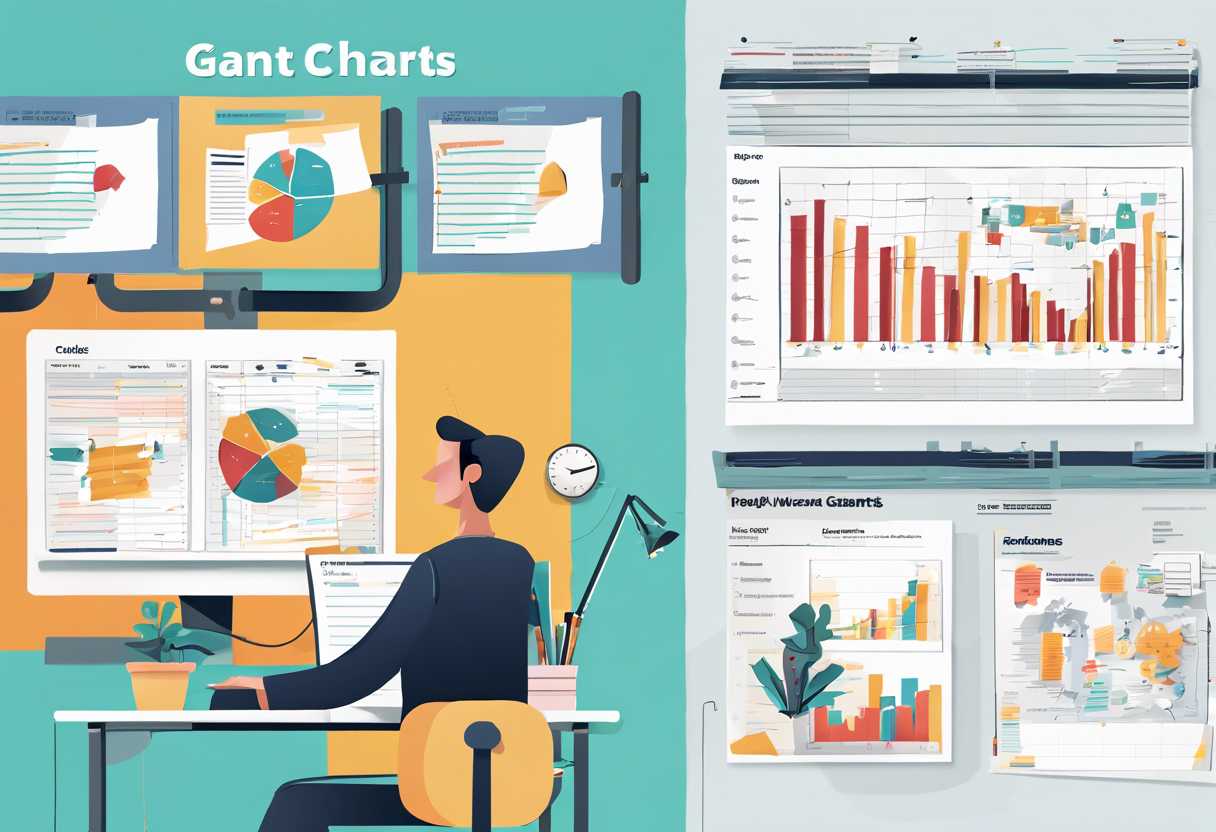Are Gantt charts dead? This question has been a topic of debate in the project management community for quite some time. With the evolution of project management tools and methodologies, many have questioned the relevance of Gantt charts in today’s fast-paced and dynamic project management landscape. In this blog post, we will explore the evolution of project management tools and discuss whether Gantt charts are still relevant. We will debunk the myth that Gantt charts are dead and highlight their continued importance in project management. Additionally, we will examine the pros and cons of Gantt charts in today’s project management landscape and discuss how they can be adapted to meet modern project management needs. Finally, we will look at the future of Gantt charts and how they fit into agile and other methodologies. Join us as we delve into the world of project management tools and explore the role of Gantt charts in today’s project management landscape.
The Evolution of Project Management Tools: Are Gantt Charts Still Relevant?
The Rise of Agile Methodologies
With the rise of agile methodologies in project management, there has been a shift towards more dynamic and flexible tools. Agile project management emphasizes collaboration, adaptability, and iterative development. This has led to the popularity of tools such as Kanban boards and Scrum boards, which offer a more visual and real-time approach to project tracking and management.
The Role of Gantt Charts in Modern Project Management
Despite the rise of agile methodologies, Gantt charts still hold relevance in modern project management. Gantt charts provide a comprehensive overview of project timelines, dependencies, and resource allocation. They offer a structured and organized approach to project planning, making it easier to identify potential bottlenecks and allocate resources effectively. Additionally, Gantt charts can be integrated with agile methodologies, providing a high-level roadmap for agile teams while still allowing for flexibility and adaptability.
Integrating Gantt Charts with Modern Project Management Tools
Many modern project management tools now offer integration with Gantt charts, allowing teams to leverage the benefits of both agile methodologies and traditional project planning. This integration provides the best of both worlds, offering the flexibility and real-time visibility of agile tools, while also providing the structured planning and resource allocation offered by Gantt charts. By integrating Gantt charts with modern project management tools, teams can effectively balance the need for adaptability with the importance of structured planning and resource management.

Debunking the Myth: Why Gantt Charts Are Far From Dead
The Evolution of Gantt Charts
Contrary to popular belief, Gantt charts have not become obsolete in today’s fast-paced project management landscape. In fact, they have evolved to become even more relevant and effective in helping teams visualize and manage complex projects. Originally developed by Henry Gantt in the early 20th century, Gantt charts have stood the test of time and continue to be a valuable tool for project planning and scheduling.
The Benefits of Gantt Charts
One of the main reasons why Gantt charts are still widely used is their ability to provide a clear and visual representation of project timelines, tasks, and dependencies. This makes it easier for project managers and team members to track progress, identify potential bottlenecks, and make informed decisions. Additionally, Gantt charts allow for easy communication and collaboration among team members, as everyone can easily see what needs to be done and when.
- Visual representation of project timelines and tasks
- Easy tracking of progress and identification of bottlenecks
- Facilitates communication and collaboration among team members
Modern Applications of Gantt Charts
With the advent of project management software, Gantt charts have become even more powerful and versatile. Today’s tools offer features such as drag-and-drop functionality, real-time updates, and integration with other project management tools, making Gantt charts an indispensable part of the project planning and execution process. Furthermore, Gantt charts can be easily customized to suit the specific needs of different projects and industries, making them a flexible and adaptable tool for modern project management.
| Feature | Benefits |
| Drag-and-drop functionality | Allows for easy and intuitive task scheduling |
| Real-time updates | Enables teams to stay informed of project progress |
| Integration with other tools | Streamlines project management processes |

The Pros and Cons of Gantt Charts in Today’s Project Management Landscape
Pros of Gantt Charts
Gantt charts offer a visual representation of a project’s timeline, allowing for easy tracking of tasks and deadlines. This visual aid can help project managers and team members stay organized and on track. Additionally, Gantt charts can help identify potential bottlenecks and resource constraints, allowing for proactive problem-solving. With the ability to easily adjust timelines and dependencies, Gantt charts provide flexibility in project planning and execution.
Cons of Gantt Charts
While Gantt charts offer many benefits, they also have some limitations. One of the main drawbacks is the potential for complexity, especially in larger projects with numerous tasks and dependencies. This complexity can make it challenging to maintain and update the Gantt chart, leading to potential inaccuracies. Additionally, Gantt charts may not be the best tool for agile or iterative project management approaches, as they are more suited for linear, sequential projects.
Another potential downside of Gantt charts is the risk of over-reliance on the visual representation, leading to a lack of detailed planning and communication. This can result in a false sense of security and oversight of critical project elements.
Conclusion
While Gantt charts have their advantages and disadvantages, they remain a valuable tool in project management. Understanding their strengths and weaknesses can help project managers make informed decisions about when and how to use Gantt charts effectively.
Adapting Gantt Charts for Modern Project Management Needs
The Evolution of Gantt Charts
Gantt charts have been a staple in project management for over a century, providing a visual representation of a project’s schedule. Originally developed by Henry Gantt in the 1910s, these charts were created manually and often lacked the flexibility needed for modern project management.
However, with the advent of digital tools and software, Gantt charts have evolved to meet the needs of today’s project managers. These modern adaptations offer enhanced features and capabilities that make them indispensable for efficient project planning and execution.
Key Features of Modern Gantt Charts
Modern Gantt charts offer a range of features that cater to the complex needs of contemporary project management. These include:
- Task Dependencies: Linking tasks to show their interdependencies and ensure a smooth workflow.
- Resource Management: Assigning resources to tasks and tracking their availability and workload.
- Collaboration Tools: Allowing team members to update progress, communicate, and share documents within the chart.
- Real-Time Updates: Providing instant visibility into project progress and any changes in the schedule.
Adapting Gantt Charts for Agile Project Management
While Gantt charts were traditionally associated with waterfall project management methodologies, they have successfully adapted to the agile approach as well. Agile Gantt charts allow for iterative planning, flexible scheduling, and dynamic adjustments based on changing requirements.
By incorporating features such as drag-and-drop functionality for task reordering, color-coded milestones for sprint planning, and burndown charts for tracking progress, modern Gantt charts seamlessly align with the principles of agile project management.
The Future of Gantt Charts: How They Fit into Agile and Other Methodologies
Gantt Charts in Agile Methodology
Traditionally, Gantt charts have been associated with waterfall project management methodologies. However, with the rise of Agile, there has been a shift in how Gantt charts are used. In Agile, Gantt charts are often used as a high-level planning tool to provide a visual representation of the project timeline and dependencies. This allows Agile teams to have a better understanding of the overall project timeline and make adjustments as needed.
Integration with Other Methodologies
Aside from Agile, Gantt charts are also finding their place in other project management methodologies such as Scrum and Kanban. While these methodologies focus on iterative and incremental delivery, Gantt charts can still be used to provide a big picture view of the project timeline and help teams coordinate their efforts. This integration allows for a more holistic approach to project management, combining the flexibility of Agile with the structure of Gantt charts.
The Evolution of Gantt Chart Software
As project management methodologies continue to evolve, so does the software that supports them. Modern Gantt chart software now offers features that cater to Agile and other methodologies, such as the ability to easily adjust timelines, visualize dependencies, and collaborate in real-time. This evolution has made Gantt charts more adaptable to different project management approaches, making them a valuable tool for a wide range of teams and projects.
Conclusion
After exploring the evolution, relevance, and adaptability of Gantt charts in today’s project management landscape, it’s clear that the question “Are Gantt charts dead?” is far from accurate. While new methodologies and tools have emerged, Gantt charts continue to offer valuable insights and benefits for project managers and teams.
Debunking the myth that Gantt charts are obsolete, we’ve highlighted their enduring relevance and effectiveness in visualizing project timelines, dependencies, and resource allocation. Despite their limitations, the pros of using Gantt charts outweigh the cons, especially when adapted to modern project management needs.
Looking ahead, the future of Gantt charts lies in their integration with agile and other methodologies, offering a complementary approach to project planning and execution. As project management continues to evolve, Gantt charts will continue to adapt and thrive in the dynamic landscape of modern business.
As you consider the role of Gantt charts in your own projects, it’s important to recognize their potential and explore how they can enhance your project management processes. Whether you’re a seasoned project manager or a newcomer to the field, Gantt charts remain a valuable tool worth incorporating into your toolkit.
Ultimately, the question of whether Gantt charts are dead is resoundingly answered with a resounding “no.” Instead, they continue to play a vital role in project management, offering a timeless framework for visualizing, planning, and executing projects with precision and clarity.
Embrace the enduring relevance of Gantt charts and discover how they can elevate your project management practices in today’s fast-paced and complex business environment.

